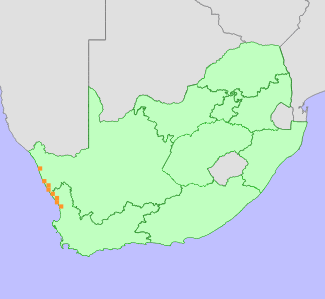|
Scientific Name | Babiana brachystachys (Baker) G.J.Lewis |
Higher Classification | Monocotyledons |
Family | IRIDACEAE |
National Status |
Status and Criteria | Near Threatened B1ab(iii)+2ab(iii) |
Assessment Date | 2021/02/25 |
Assessor(s) | T. Patel, D. Raimondo & N.A. Helme |
Justification | This species has an extent of occurrence (EOO) of 2550 km², and an area of occupancy (AOO) of 60 km². Heavy mineral sand mining has caused some decline for this taxon with two historical subpopulations from Namaqua Sands likely to be extinct. However this species occurs on strandveld and sandveld vegetation and is therefore buffered by the fact that alot of Sandveld habitat is still extant, and only a small proportion of the dunes on which it occurs have been mined (1%). It is currently known from eight locations but is likely to be under-collected as many parts of its range have not yet been surveyed. It is suspected to occur at between 10 and 15 locations. Loss to heavy mineral sand mining is ongoing. It almost meets the thresholds for listing as Vulnerable under criterion B, and is therefore listed as Near Threatened. |
Distribution |
Endemism | South African endemic |
Provincial distribution | Northern Cape |
Range | It is endemic to South Africa, and is found in Coastal Namaqualand between Lambert's Bay and Kleinsee. |
Habitat and Ecology |
Major system | Terrestrial |
Major habitats | Succulent Karoo |
Description | It grows on deep white sands near the coast, in West Coast strandveld and sandveld vegetation. |
Threats |
| Heavy mineral sand mining has caused some decline for this taxon, but it is not significant (1% habitat loss calculated using landcover data in GIS). The subpopulation represented by herbarium collections from Namaqua Sands is likely to be extinct. This species occurs on strandveld and sandveld vegetation and is therefore buffered by the fact that a lot of sandveld habitat is still extant. It is also under threat from habitat degradation to agriculture. |
Population |
There is not much known about the population numbers of this species. It is found at at least 8 locations but is likely still under collected. There are only four records on iNaturalist which may be an indication that this species is not common.
|
Population trend | Decreasing |
Assessment History |
Taxon assessed |
Status and Criteria |
Citation/Red List version | | Babiana brachystachys (Baker) G.J.Lewis | Declining | Raimondo et al. (2009) | | Babiana brachystachys (Baker) G.J.Lewis | Insufficiently Known | Hilton-Taylor (1996) | | Babiana brachystachys (Baker) G.J.Lewis | Uncertain | Hall et al. (1980) | |
Bibliography |
Goldblatt, P. and Manning, J.C. 2007. A revision of the southern African genus Babiana, Iridaceae, Crocoideae. Strelitzia 18:1-97. South African National Biodiversity Institute, Pretoria.
Hall, A.V., De Winter, M., De Winter, B. and Van Oosterhout, S.A.M. 1980. Threatened plants of southern Africa. South African National Scienctific Programmes Report 45. CSIR, Pretoria.
Hilton-Taylor, C. 1996. Red data list of southern African plants. Strelitzia 4. South African National Botanical Institute, Pretoria.
Lewis, G.J. 1959. The genus Babiana. Journal of South African Botany Supplement 3:1-149.
Raimondo, D., von Staden, L., Foden, W., Victor, J.E., Helme, N.A., Turner, R.C., Kamundi, D.A. and Manyama, P.A. 2009. Red List of South African Plants. Strelitzia 25. South African National Biodiversity Institute, Pretoria.
|
Citation |
| Patel, T., Raimondo, D. & Helme, N.A. 2021. Babiana brachystachys (Baker) G.J.Lewis. National Assessment: Red List of South African Plants version 2024.1. Accessed on 2025/12/02 |
 Comment on this assessment
Comment on this assessment


